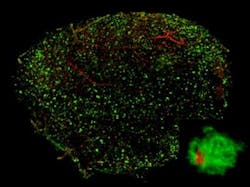Better 'optical clearing' makes transparent brains more stable
Researchers at the RIKEN Brain Science Institute (Wako-city, Japan) have, for a few years now, been working on a technique to allow brain researchers to easily see structures deep inside the (nonliving) brain. Called "optical clearing," it involves soaking a brain in fluids that infiltrate the brain and reduce optical scattering.
While previous fluids based on urea turned the brain transparent, the fluid would often damage the very brain structures that it was revealing. Now, the RIKEN researchers have created a new fluid variant that does not alter brain tissue.1 The method is called "ScaleS."
"The key ingredient of our new formula is sorbitol, a common sugar alcohol," says lead scientist Atsushi Miyawaki. "By combining sorbitol in the right proportion with urea, we could create transparent brains with minimal tissue damage that can handle both fluorescent and immunohistochemical labeling techniques, and is even effective in older animals."
The technique has already given new insights into diffuse Alzheimer's disease plaques as well as active microglial cells also associated with the disease.
REFERENCE:
1. Hiroshi Hama et al., Nature Neuroscience (2015); doi: 10.1038/nn.4107.
Source: http://www.eurekalert.org/pub_releases/2015-09/r-rxv091115.php

John Wallace | Senior Technical Editor (1998-2022)
John Wallace was with Laser Focus World for nearly 25 years, retiring in late June 2022. He obtained a bachelor's degree in mechanical engineering and physics at Rutgers University and a master's in optical engineering at the University of Rochester. Before becoming an editor, John worked as an engineer at RCA, Exxon, Eastman Kodak, and GCA Corporation.
